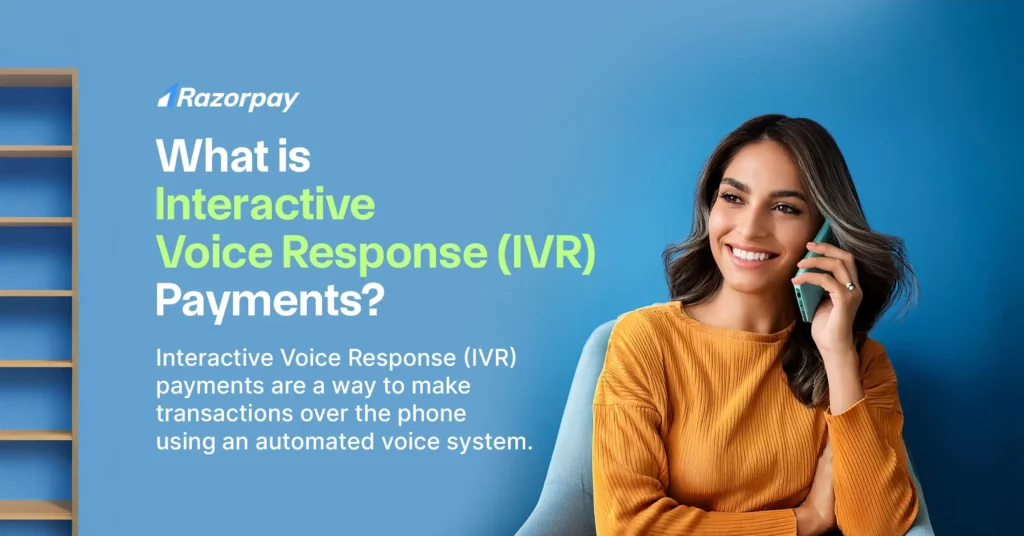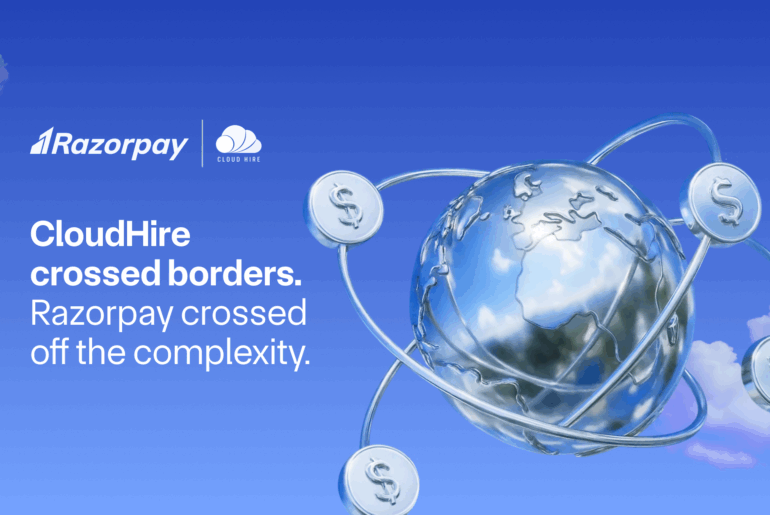Contactless payment methods have surged in popularity during the global health crisis that began in 2020. In this era of contactless payments, Interactive Voice Response (IVR) payments offer a convenient and secure way for customers in India to make transactions over the phone, eliminating the need for physical contact.
Table of Contents
What is an IVR Payment?
The full form of IVR in banking is Interactive Voice Response. It is a phone-based transaction system that enables customers to make payments by mobile phone without interacting with a live agent. To process an IVR payment, callers use their phone’s touch-tone keypad to enter debit or credit card details securely.
This self-service process facilitates 24/7 debit and credit card payments without requiring human assistance. IVR payments offer a convenient, secure option for customers to manage payments by phone, simplifying transactions and enhancing overall customer experience.
Types of IVR Payments in Banking
1. Voice-Based Payments
Voice-based payments leverage advanced voice recognition to allow a user to request a transaction verbally, making the transaction more natural and easy.
Example of Voice-Based Payments
A customer calls a utility provider’s IVR system and says, “I want to pay my bill.” The system then guides the customer through the payment process using voice prompts, allowing them to enter payment information verbally.
2. Touch-Tone Payments
Example of Touch-Tone Payments
3. Hybrid IVR Payments
Hybrid IVR payments integrate voice and touch-tone inputs, enabling customers to select their preferred interaction mode. Customers may communicate their payment information or use the keypad, whichever seems convenient.
Example of Hybrid IVR Payments
A customer may enter their account number using voice commands and then switch to touch-tone for credit card information.
Common Use Cases for IVR Payments
1. Finance and Banking
Debt Collection
IVR systems can be used to automate debt collection processes, sending reminders and facilitating payment arrangements.
Credit Card and Loan Payments
Customers can make payments for credit cards, loans, and instalments directly through IVR, reducing the need for in-person visits or manual processing.
Fraud Detection
IVR systems can help detect and prevent fraudulent activity by monitoring transaction patterns and identifying suspicious behaviour.
Payout Settlements
IVR can be used to automate payout settlements, ensuring timely and accurate disbursements.
Balance Updates
Customers can quickly check their account balances and transaction history using IVR.
2. Healthcare
Medical Bill Collection
IVR can automate the collection of medical bills, providing patients with convenient payment options and reminders.
Payment Plan Setup
Patients can set up payment plans to manage their medical bills more effectively.
3. Service Providers
Subscription Management
IVR can be used to manage subscription-based services, allowing customers to modify or cancel their subscriptions.
Recurring and One-Time Fees
IVR can facilitate the collection of recurring payments or one-time service fees.
IVR Bill Payment
Users can conveniently pay bills, including electricity, water, education fees, and more, directly over the phone through IVR bill payment.
4. Event Management
Ticket Sales
IVR can be used to sell tickets for events, providing a convenient and accessible option for customers.
Donation Collection
IVR can collect one-time or regular donations for events or causes.
5. Customer Loyalty
Reward Program Setup
IVR can be used to set up customer loyalty programs that reward customers for making timely payments.
6. Customer Satisfaction
Efficient Routing
IVR can help improve customer satisfaction by routing callers to the appropriate departments or agents.
Reduced Hold Times
IVR can decrease hold times, reducing customer frustration and improving overall satisfaction.
Self-Service Options
IVR can provide self-service options, allowing customers to resolve issues without waiting for an agent.
Merchants can integrate IVR payments with Razorpay – the best payment gateway in India, one of India’s top successful payment gateways.
IVR System Features and Components
An IVR Payment system is made up of several fundamental features that work together to enable safe transactions over the phone.
The key components are:
1. Interactive voice response (IVR) software
It provides automated voice prompts and options to help customers throughout the payment process.
2. Automatic speech recognition (ASR)
ASR enables IVR systems to interpret customer responses and keypad input.
3. Text-to-speech (TTS)
It converts the written text into spoken words for the IVR voice prompts.
4. Payment gateway
The customer’s encrypted payment information is securely transmitted and processed through payment gateway.
5. TCP/IP Network
This network provides the necessary connectivity between the IVR system and other components, ensuring reliable communication and data transfer.
6. Databases
Databases store essential data such as customer information, transaction history, and product details, which the IVR system needs to function effectively.
7. Web/Application Server
The web/application server hosts the IVR software, making it accessible to users and allowing it to operate seamlessly.
Key Technology Used in IVR Payments
1. DTMF (Dual-Tone Multi-Frequency)
This technology enables users to input information using their phone’s keypad.
2. Voice Recognition
Advanced voice recognition software allows users to interact with the IVR system using spoken commands.
3. Text-to-Speech (TTS)
TTS converts written text into spoken words, generating the voice prompts that guide users through the IVR system.
4. Natural Language Processing (NLP)
NLP enables the IVR system to understand and respond to natural language queries, providing a more conversational experience.
5. Speech Synthesis
This technology generates human-like speech for the IVR system’s voice prompts.
6. Database Integration
IVR systems often integrate with databases to store customer information, transaction history, and other relevant data.
7. Payment Gateway Integration
A payment gateway is essential for processing payments securely and efficiently.
8. Cloud-Based Infrastructure
Many IVR systems are now hosted on cloud platforms, offering scalability and flexibility.
How to Make IVR Payment? A Step-By-Step Guide
Here’s the step-by-step guide to make IVR payments:
STEP 1: Customer Call Initiation
When a customer dials a designated number for IVR payments, the call is immediately routed to the IVR system. The IVR system greets the customer with a welcome message.
STEP 2: Voice Prompts and Menu Navigation
The IVR system plays pre-recorded voice prompts to show them all the available payment methods from the menu.
Depending on the system’s capabilities, customers can use their phone’s touch-tone keypad inputs (DTMF tones) or voice instructions to select the options from menu.
STEP 3: Enter Payment Informations
The IVR system prompts the customer to enter their payment details, such as credit or debit card number, expiration date, CVV and the payment amount.
The customer can enters their payment informations using their phone’s dial pad.
STEP 4: IVR Payment Data Encryption
The collected payment information are encrypted immediately to protect it from the unauthorized access.
Data encryption ensures the security of payment informations during the data transmission for payment process.
STEP 5: IVR Payment Processing
The encrypted payment data is securely transmitted to a payment gateway.
The payment gateway verifies the debit or credit card details, checks for sufficient funds, and authorizes the transaction.
STEP 6: IVR Payment Confirmation
If the IVR payment is successful, the IVR system will issue a transaction reference number and can issue a receipt via email or SMS.
If the IVR payment fails, the IVR system will notify the user, advise them through troubleshooting processes, and provide alternate payment options.
Enhanced Security Measures for IVR Payments
1. PCI-DSS Compliance
IVR payment platforms must follow PCI-DSS standards set by major card brands like American Express, Visa, Discover, and Mastercard. This framework includes 12 essential requirements to protect customer data.
The PCI Compliance requirements include the following:
- Installing and maintaining firewalls
- Avoiding the use of vendor default passwords
- Encrypting cardholder data transmission across public networks
- Protecting stored customer and card data
- Using and updating antivirus software
- Assigning IP addresses and unique IDs to each user
- Creating and maintaining a company security and privacy policy
- Regularly testing security processes
- Only sharing cardholder information on a need-to-know basis
- Restricting and securing physical access to cardholder information
- Monitoring cardholder data and network access
- Creating and maintaining secure applications, software, and systems
2. Anti-Fraud Measures
To ensure security, IVR systems should integrate:
- Fraud Detection Algorithms: Use sophisticated algorithms to spot and block suspicious activities.
- Velocity Checks: Track transaction patterns to flag unusual behaviour, such as multiple transactions in a short time.
- Behavioural Analytics: Assess customer behaviour to detect potential fraud signals.
- Software Encryption: Protect sensitive data with strong encryption during transmission and storage, including card numbers and CVV codes.
3. 3D Secure
For HDFC Bank card transactions, 3D Secure adds an extra layer of security, requiring authentication via a password or one-time code.
4. Authentication
Verify user identity with account details and personal information that only the customer knows, such as PINs or security questions.
Implementing these robust security measures helps IVR payment platforms minimize fraud risks and safeguard customer data.
What are the Common Errors that Occur During IVR Payments?
1. Voice recognition errors: The system may not understand what the caller is saying or asking.
Solution: Improve the accuracy of the voice recognition technology and provide clear prompts to guide the caller.
2. Long menus: The menus may be long and complex.
Solution: Simplify menus and provide more options for direct access to specific tasks.
3. Lack of human touch: Customers may feel like they can’t reach a human representative.
Solution: Offer a clear path to connect with a live agent and ensure a seamless transfer.
4. Poor integration: The IVR may not integrate well with other channels.
Solution: Ensure that the IVR system is integrated with other customer service channels, such as email and chat, to provide a consistent experience.
In the event of a more difficult problem, the IVR may smoothly transfer the call to a live person who can further help the consumer while retaining the context of the encounter.
Advantages of IVR Payments
1. Streamlined Payment Processes
IVR system automates transactions for fast and efficient payments without needing agent contact.
2. Enhanced Customer Experience
Provides 24/7 access, eliminating endless ringing and reducing wait times. Customers are quickly directed to the most relevant person or department, improving satisfaction.
Clearly presents options using voice prompts, with a “talk to a real person” choice if needed.
3. Increased Agent Availability
Handles routine inquiries and simple tasks, freeing up agents to focus on complex issues. Reduces errors in call transfers and ensures customers reach the right department.
4. Faster Processing and Reduced Late Payments
Accelerates processing by allowing customers to navigate through options quickly. Notifications and automatic payment setups prevent missed deadlines. Payment plans and secure storage facilitate timely transactions.
5. Cost Efficiency
Lowers operational costs by reducing staffing needs and minimizing manual data entry errors. Greater efficiency means fewer employees can handle more calls and tasks.
6. 24/7 Non-Stop Availability
IVR system operates around the clock 24/7, allowing customers to engage with the system any time, even if it means leaving a message. This continuous availability enhances customer perception and encourages return business.
7. Brand Connection and Better Mobile Experience
Customizable to fit company branding and customer needs, improving brand perception. Mobile users benefit from efficient, rapid solutions, accommodating their limited time and boosting the likelihood of return.
8. Freed-Up Employee Time
Handles simple queries like business hours or gift card balances, allowing employees to concentrate on more complex projects.
Future of IVR Payments
IVR systems are poised for significant advancements, driven by emerging technologies.
1. Personalized Experiences
Future IVR systems will leverage machine learning algorithms to tailor interactions based on individual customer profiles and preferences, creating a more personalized and engaging experience.
2. Enhanced AI and NLP
Artificial intelligence and natural language processing will further refine speech recognition and understanding, enabling more natural and intuitive conversations with customers.
3. Omnichannel Integration
IVR payments will seamlessly integrate with other payment channels, such as mobile apps and online portals, providing a unified and convenient experience for customers.
4. Real-time Updates and Reminders
IVR systems will offer real-time updates on transactions and send automatic reminders to ensure timely payments and reduce late fees.
5. Enhanced Security
Advanced security measures, including biometric authentication and fraud detection, will be implemented to protect customer data and prevent unauthorized access.
Frequently Asked Questions
1. What does IVR OTP mean?
An IVR OTP is a 6-digit one-time password sent to your registered mobile number. You enter this OTP during an IVR transaction to securely complete payments or verify your identity over the phone.
2. Is IVR payment secure?
Yes, IVR payments are secure, adhering to PCI and NACHA standards. Data is encrypted, and access is restricted to protect customer information.
3. What are examples of IVR?
IVR is used in banking for account inquiries, eCommerce for order updates, customer care for billing questions, and healthcare for appointment scheduling.
4. What is the meaning of IVR transfer?
IVR transfer moves a call from a live agent to an IVR system for additional input or verification, often used for surveys or service confirmation.
5. Can I make international payments using IVR?
Yes, IVR systems support international payments through an international payment gateway, allowing transactions from anywhere with secure data handling in compliance with PCI DSS.
6. Are there any fees associated with IVR payments?
Yes, IVR payments may incur per-transaction fees, setup fees, or monthly support charges, depending on the provider and payment method.
7. What information is needed for IVR payment transactions?
IVR payments require an account or invoice number, payment details like (credit or debit card numbers, expiration dates, CVV), and the transaction amount.
8. What is IVR payment gateway?
An IVR payment gateway securely processes phone-based IVR payments by acting as a trusted intermediary between banks and customers.
9. What is IVR in Banking?
IVR in banking is an automated phone system that allows customers to interact with their bank using voice commands or keypad inputs. It provides services like balance inquiries, fund transfers, and bill payments without the need to speak to a bank representative.


